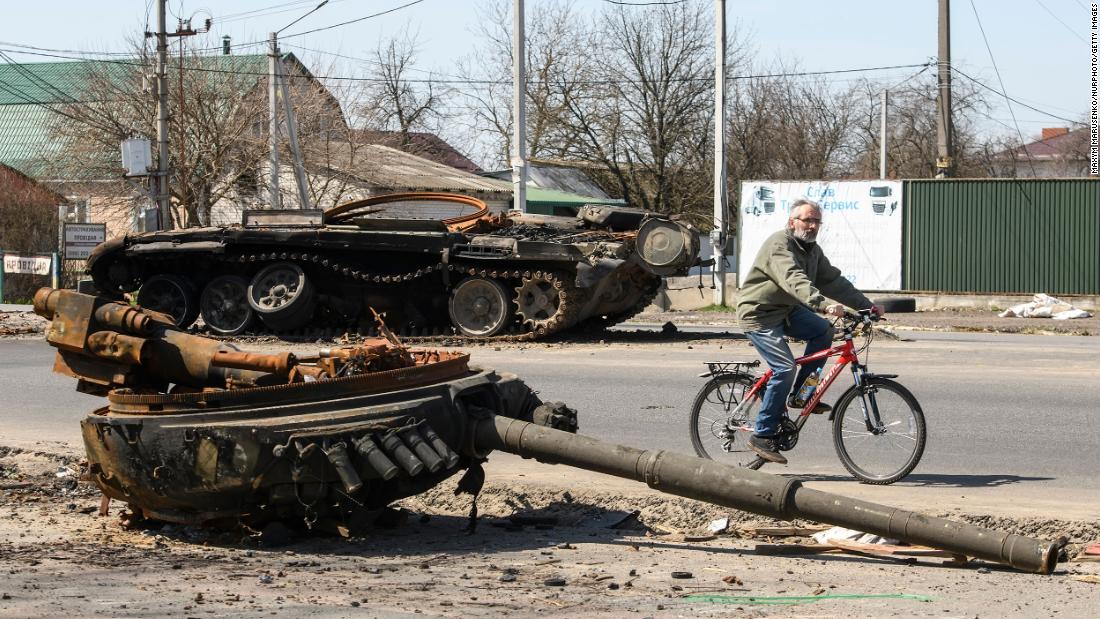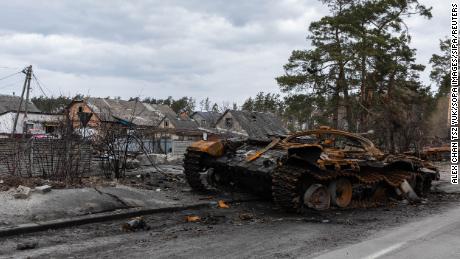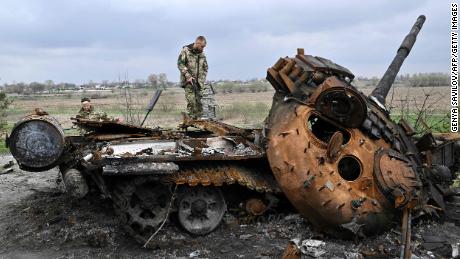
Hundreds of Russian tanks are thought to have been destroyed since Moscow launched its offensive, with British Defense Secretary Ben Wallace on Monday estimating it had lost as many as 580.
But Moscow’s problems go beyond the sheer number of tanks it has lost. Experts say battlefield images show Russian tanks are suffering from a defect that Western militaries have known about for decades and refer to as the “jack-in-the-box effect.” Moscow, they say, should have seen the problem coming.
The problem relates to how the tanks’ ammunition is stored. Unlike modern Western tanks, Russian ones carry multiple shells within their turrets. This makes them highly vulnerable as even an indirect hit can start a chain reaction that explodes their entire ammunition store of up to 40 shells.
The resulting shockwave can be enough to blast the tank’s turret as high as a two-story building, as can be seen in a recent video on social media.
“What we are witnessing with Russian tanks is a design flaw,” said Sam Bendett, an adviser with the Russian Studies Program at the Center for a New American Security.
“Any successful hit … quickly ignites the ammo causing a massive explosion, and the turret is literally blown off.”
The flaw means the tank’s crew — usually two men in the turret and a third driving — are sitting ducks, said Nicholas Drummond, a defense industry analyst specializing in land warfare and a former British Army officer.
“If you don’t get out within the first second, you’re toast.”
The ‘jack-in-the-box” effect
Drummond said exploding munitions are causing problems for almost all of the armored vehicles Russia is using in Ukraine. He gave the example of the BMD-4 infantry fighting vehicle, typically manned by up to three crew and able to carry another five soldiers. He said the BMD-4 was a “mobile coffin” that was “just obliterated” when hit by a rocket.
But the design flaw with its tanks should be particularly galling for Moscow as the problems have been so widely telegraphed.
They came to the attention of Western militaries during the Gulf wars against Iraq in 1991 and 2003, when large numbers of the Iraqi army’s Russian-made T-72 tanks suffered the same fate — turrets being blown from their bodies in anti-tank missile strikes.
Drummond said Russia hadn’t learned the lessons from Iraq and that consequently many of its tanks in Ukraine featured similar design flaws with their autoloading missile systems.
When the T-90 series — the successor to the T-72 — came into service in 1992 its armor was upgraded but its missile loading system remained similar to its predecessor’s, leaving it just as vulnerable, Drummond said. The T-80, another Russian tank seeing action in the Ukraine invasion, has a similar missile loading system.
There are some benefits to such a system. Bendett, at the Center for a New American Security, said Russia had chosen this system to save space and give the tanks a lower profile, making them harder to hit in battle.
Western militaries, however, had been spurred into action by the T-72’s fate in Iraq.
“(Western militaries) all learned from the Gulf War, and from seeing tanks killed during that time, that you have to compartmentalize the ammunition,” Drummond said.
He pointed to the US military’s Stryker infantry fighting vehicles developed after the first war in Iraq.
“That has a turret that sits on top, and that turret does not enter the crew compartment. It purely sits on top and all the ammunition is inside that turret,” he said. “So if the turret gets hit and blown off, the crew is still safe below. That’s a very clever design.”
Other Western tanks, such as the M1 Abrams used by the US and some allied armies, are larger and have no carousel. In the Abrams, a fourth crew member in the tank retrieves shells from a sealed compartment and transfers them to the gun for firing.
The compartment has a door that the crew member opens and closes between each shot taken by the tank, meaning that if the tank is hit, only one shell is likely to be exposed in the turret.
“An accurate hit can damage the tank, but not necessarily kill the crew,” Bendett said.
And Drummond said the shells used by Western militaries sometimes burn under the high heat generated by an incoming missile, but they don’t explode.
Hard to replace
However, the site only counts instances where it has visual evidence, so Russian losses could be much higher.
And these losses are not just about equipment. When Wallace, the British defense secretary, gave his estimate of 580 lost tanks to the House of Commons he also said more than 15,000 Russian military personnel had been killed during its invasion.
It’s hard to know how many of those are tank crew, but what is not in doubt is that the crews are not easy to replace.
Training a tank crew could take up to 12 months, said Aleski Roinila, a former tank crewman in the Finnish Defense Forces, “and that’s considered quick.”
And for Russia to replace hundreds of crew at this point in the war would be a tall order — especially when the tanks they are expected to use are so flawed.


